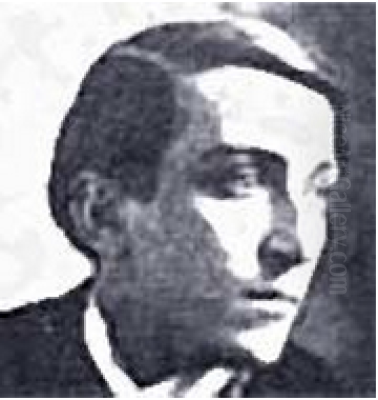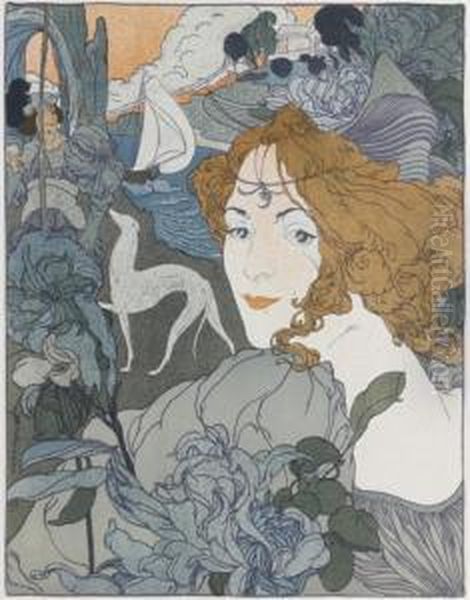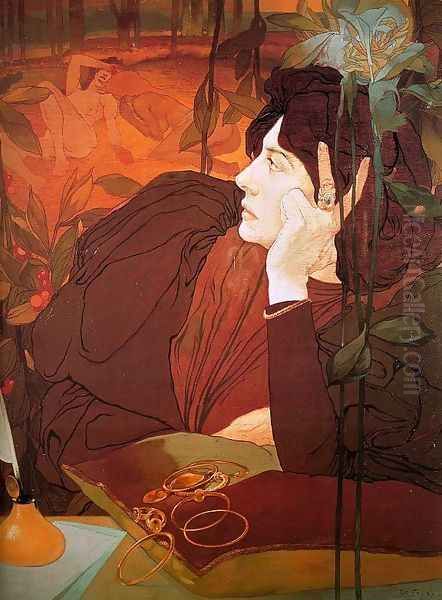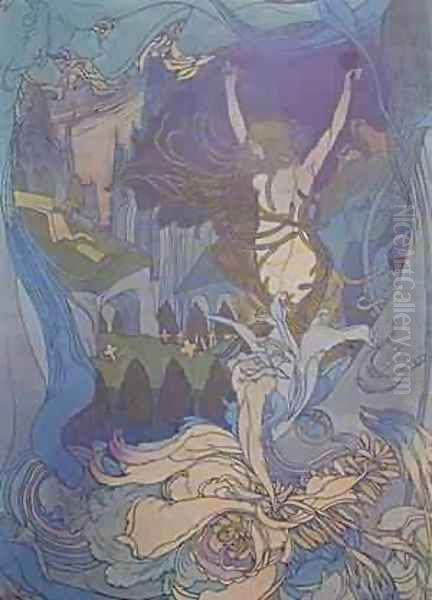
Georges de Feure, born Georges Joseph van Sluÿters, stands as a pivotal yet sometimes underappreciated figure in the vibrant artistic landscape of late 19th and early 20th century Paris. Active during the flourishing periods of Symbolism and Art Nouveau, de Feure was a remarkably versatile artist whose talents spanned painting, graphic design, theatrical design, and the creation of exquisite decorative and industrial arts. His unique aesthetic, often characterized by ethereal female figures, intricate floral motifs, and a subtle melancholy, captured the zeitgeist of the fin-de-siècle, leaving an indelible mark on the visual culture of his time.
Early Life and Artistic Awakening
Georges de Feure was born in Paris on September 6, 1868. His parentage reflected a blend of European cultures: his father was a Dutch architect, and his mother was Belgian. This cosmopolitan background perhaps contributed to the diverse influences apparent in his later work. His early artistic inclinations led him to Amsterdam, where he enrolled at the prestigious Rijksakademie van beeldende kunsten (Royal Academy of Fine Arts). However, de Feure found the structured, academic environment stifling. After only a couple of years, his independent spirit and dissatisfaction with formal education prompted him to leave.
Seeking a more stimulating and creatively liberating atmosphere, de Feure made the pivotal decision to return to Paris, the undisputed art capital of Europe. He arrived in 1889 and settled in Montmartre, the bohemian heart of the city, teeming with artists, writers, and performers. It was here, amidst the cabarets and studios, that de Feure truly began to forge his artistic identity, largely as a self-taught artist. He absorbed the myriad influences of the Parisian art scene, from the lingering romanticism to the burgeoning avant-garde movements.
Embracing Symbolism
The late 1880s and 1890s saw the ascendancy of Symbolism, a literary and artistic movement that reacted against the naturalism and realism that had dominated much of the 19th century. Symbolist artists sought to express subjective truths, emotions, and mystical ideas, often through suggestive imagery, allegory, and dreamlike atmospheres. De Feure was drawn to this introspective and evocative mode of expression, and he quickly became recognized as an important figure within the Symbolist milieu.

His Symbolist works often feature enigmatic female figures, the quintessential femme fragile or femme fatale, embodying themes of desire, mystery, and the ephemeral nature of beauty. These women are frequently depicted in languid poses, surrounded by symbolic flora or set against ethereal, otherworldly landscapes. His palette during this period often leaned towards muted tones, creating a sense of introspection and melancholy. Literary influences, such as the poetry of Charles Baudelaire, Stéphane Mallarmé, and Paul Verlaine, as well as the decadent prose of Joris-Karl Huysmans, resonated deeply with Symbolist artists like de Feure, providing rich thematic material.
De Feure actively participated in key Symbolist exhibitions. He showed his work at the Salons de la Rose+Croix in 1893 and 1894, organized by the eccentric Sâr Joséphin Péladan. These Salons were dedicated to an art that was idealistic, mystical, and often esoteric, rejecting the mundane and embracing the spiritual. His involvement placed him in the company of other prominent Symbolists, and his watercolors, in particular, received critical acclaim. He also exhibited with artists like Paul Gauguin and members of the Nabis group, such as Pierre Bonnard and Édouard Vuillard, at galleries like Le Barc de Boutteville, which championed avant-garde art. His contemporaries in the broader Symbolist movement included figures like Gustave Moreau, Odilon Redon, and Pierre Puvis de Chavannes in France, as well as Fernand Khnopff in Belgium and Jan Toorop in the Netherlands, whose works shared a similar concern with the inner world and symbolic representation.
The Zenith of Art Nouveau
While deeply rooted in Symbolism, Georges de Feure became one of the most distinguished and versatile practitioners of Art Nouveau. This "new art," which flourished from the 1890s to the brink of World War I, sought to break down the traditional hierarchy between fine and applied arts, creating a unified aesthetic that permeated all aspects of life. Characterized by organic, sinuous lines, stylized natural forms (especially flowers and plants), and a commitment to craftsmanship, Art Nouveau found expression in architecture, interior design, furniture, glassware, jewelry, and graphic arts.
De Feure’s transition into Art Nouveau was seamless, as the movement’s emphasis on decorative beauty and symbolic meaning aligned well with his existing sensibilities. His most significant collaboration in this realm was with Siegfried Bing, the influential German-French art dealer whose Parisian gallery, Maison de l'Art Nouveau, opened in 1895 and effectively gave the movement its name. Bing was a fervent promoter of this new style and commissioned de Feure to design a wide array of objects for his gallery.

The pinnacle of their collaboration, and a major highlight of de Feure's career, was his contribution to the 1900 Exposition Universelle in Paris. Bing entrusted de Feure with the design of the façade and two complete interiors – a boudoir and a dressing room – for the Art Nouveau Bing pavilion. These ensembles, featuring furniture, textiles, and decorative objects all conceived by de Feure, were widely praised for their elegance, harmony, and innovative design. The furniture, often crafted from luxurious woods and adorned with delicate inlays or bronze mounts, showcased his mastery of curvilinear forms and refined ornamentation. His designs for the pavilion solidified his reputation as a leading Art Nouveau designer. There remains some anecdotal mystery as to whether the original prototype for the pavilion was ever fully replicated, adding a layer of intrigue to this significant commission.
Beyond the Bing pavilion, de Feure designed an extensive range of decorative arts, including exquisite glassware, often featuring floral motifs and iridescent surfaces, ceramics, lampshades, wallpaper, and metalwork. His work in these areas demonstrated a keen understanding of materials and techniques, always infused with his signature graceful aesthetic. He was a true proponent of the Art Nouveau ideal of the Gesamtkunstwerk, or total work of art, where every element of an environment is harmoniously designed. Other key figures in French Art Nouveau whose work shares a similar spirit of innovation and elegance include Hector Guimard (famous for his Paris Métro entrances), Louis Majorelle (furniture), Émile Gallé (glass and furniture), and René Lalique (glass and jewelry). In Belgium, Victor Horta was a leading architect and designer in the style.
A Master of Multiple Disciplines
Georges de Feure’s artistic output was remarkably diverse, extending far beyond painting and decorative arts into graphic design and theatrical production. This versatility was a hallmark of his career and underscored his commitment to infusing art into everyday life.
Painting and Works on Paper:
Throughout his career, de Feure continued to paint, primarily in watercolor and oils. His paintings often retained the Symbolist preoccupation with mood and atmosphere, frequently depicting elegant women in contemplative or dreamlike states. His landscapes, such as Maisons au bord de l'eau (Houses by the Water, c. 1900-1903), showcase a delicate touch and a keen sense of color, often revealing the influence of Japanese art in their flattened perspectives and decorative compositions. His watercolors, in particular, were praised for their subtle gradations of color and ethereal quality.
Illustration and Poster Design:

De Feure was a prolific and sought-after illustrator and poster artist. He contributed to numerous prominent Parisian journals and magazines, including Le Figaro Illustré, Les Modes, Le Théâtre, Cocorico, and La Plume. His illustrations and cover designs captured the fashionable elegance and artistic ferment of the Belle Époque. He also created striking posters for various products and events. While perhaps not as revolutionary as Jules Chéret, who is often called the father of the modern poster, or as boldly expressive as Henri de Toulouse-Lautrec, de Feure’s posters are distinguished by their refined lines, harmonious color palettes, and sophisticated compositions, perfectly embodying the Art Nouveau aesthetic. One notable poster is La Dépêche/Han d'Islande (1902).
Theatrical and Industrial Design:
His talents also extended to the world of theatre, where he designed stage sets and costumes. This work allowed him to create immersive visual environments, further blurring the lines between art and life. In the realm of industrial design, beyond his work for Bing, de Feure designed furniture for firms like Maison Krieger and even ventured into fashion design, collaborating with the renowned couturière Madeleine Vionnet. He also designed book arts, collaborating with bibliophiles like Octave Uzanne to promote the book as an art object.
Key Works and Their Characteristics
Several works stand out in Georges de Feure’s oeuvre, exemplifying his distinct style and thematic concerns:
La Voix du Mal (The Voice of Evil): This Symbolist painting is a powerful and somewhat unsettling work. It depicts a woman seemingly drawn towards a shadowy, perhaps lesbian, temptation, and has been interpreted as a critique of the puritanical mores of his time. The ambiguous narrative and charged atmosphere are characteristic of his Symbolist explorations of the human psyche and forbidden desires.
Retour (Return, 1897): A color lithograph, Retour is a quintessential Art Nouveau piece. It features an elegant woman, her form echoing the sinuous lines of the surrounding stylized flowers and natural elements. The composition is decorative and harmonious, with a dreamlike quality that also harks back to his Symbolist roots.
Journal des Ventes (Auction Magazine, 1898): Another color lithograph, this work likely served as a promotional piece or cover. It depicts a woman seated at a desk, surrounded by objects, rendered in de Feure’s characteristic elegant lines and rich, yet subtle, color palette. It showcases his skill in graphic design and his ability to imbue even commercial art with artistic merit.
Furniture for Siegfried Bing (1900 Paris Exposition Universelle): The ensembles he designed for Bing's pavilion, particularly the boudoir, are considered masterpieces of Art Nouveau furniture. Characterized by slender, flowing lines, exquisite craftsmanship, and the use of fine materials like mahogany, satinwood, and gilt bronze, these pieces embody grace and sophistication. The floral marquetry and delicate carvings are typical of his decorative style.
Maisons au bord de l'eau (Houses by the Water, c. 1900-1903): This landscape painting, likely a watercolor, demonstrates de Feure’s sensitive handling of color and atmosphere. The influence of Japonisme is evident in the composition and the delicate rendering of natural forms, creating a serene and picturesque scene.
Candlesticks (c. 1905): His designs for smaller decorative objects, such as a pair of bronze candlesticks from around 1905, show his ability to translate the flowing lines of Art Nouveau into three-dimensional forms, often incorporating stylized plant or figurative motifs.
Influences and Artistic Circle
Georges de Feure’s art was a synthesis of various influences, most notably Symbolism, Art Nouveau, and Japonisme. The impact of Japanese art, particularly Ukiyo-e woodblock prints by artists like Hokusai and Utamaro, was profound on many European artists of the late 19th century, and de Feure was no exception. This influence is visible in his use of flattened perspectives, asymmetrical compositions, bold outlines, and decorative patterning, especially in his graphic works and landscapes.
He was undoubtedly aware of the work of Jules Chéret, whose vibrant posters revolutionized graphic design in Paris. While not a formal student, de Feure absorbed Chéret’s innovations in lithography and the use of dynamic female figures in advertising. His connections within the Symbolist movement were significant, exhibiting alongside Gauguin and the Nabis, and participating in the esoteric Salons de la Rose+Croix. His collaboration with Siegfried Bing was crucial for his development as an Art Nouveau designer, placing him at the forefront of the movement. He also collaborated with the architect Henri Sauvage on the decoration of the Café de Paris, further demonstrating his engagement with the applied arts.
Later Years, Legacy, and Critical Reception
Despite his significant contributions and the recognition he received, including being made a Chevalier of the Legion of Honour in 1901 for his services to the decorative arts, Georges de Feure’s later life was marked by hardship. The Art Nouveau style, once the height of fashion, began to wane in popularity with the rise of modernism in the years leading up to and following World War I. De Feure continued to work, but the changing artistic tides and economic instability likely impacted his career. He died in Paris on November 26, 1943, during the Nazi occupation, reportedly in poverty.
Posthumously, Georges de Feure’s work has been re-evaluated and increasingly appreciated. Retrospectives of his art have been held in major cities, including Tokyo, Osaka, and Paris, bringing his diverse talents to a wider audience. His works are now held in the collections of prestigious museums worldwide, such as the British Museum in London and the Bibliothèque Nationale de France in Paris, as well as many specialist Art Nouveau and decorative arts museums.
Academic reception of de Feure is generally positive, acknowledging him as one of the most versatile and original artists of his era. He is praised for his elegant synthesis of Symbolist introspection and Art Nouveau decorative flair. However, some critics have occasionally suggested that his work, particularly in its embrace of Japonisme, could sometimes appear more decorative than profound, or that he was perhaps too reliant on established motifs. Nevertheless, his skill as a draftsman, his refined color sense, and his innovative approach to design are widely recognized.
His works appear periodically on the art market. Auction results vary widely depending on the medium, scale, rarity, and provenance of the piece. Lithographs and smaller decorative items might fetch modest sums, while significant paintings or unique pieces of furniture can command higher prices, reflecting his status as a key Art Nouveau designer. For instance, works like Le Journal des Ventes or Maisons au bord de l'eau have appeared at auction, though specific high-profile sales are not always widely publicized. Estimates for works like the 1902 lithograph LA DEPECHE/HAN D'ISLANDE have reached into the thousands of dollars, while smaller watercolors or decorative items might be estimated in the hundreds to low thousands.
Conclusion
Georges de Feure was an artist of exceptional talent and remarkable versatility. He navigated the complex artistic currents of the fin-de-siècle with grace and originality, making significant contributions to both Symbolism and Art Nouveau. From his evocative Symbolist paintings and delicate watercolors to his elegant Art Nouveau furniture, glassware, and posters, de Feure’s work consistently displays a refined aesthetic, a mastery of line and color, and a deep understanding of decorative harmony. Though his later years were shadowed by hardship, his legacy endures as a testament to an artist who sought to beautify the world around him, leaving behind a rich and varied body of work that continues to enchant and inspire. He remains a crucial figure for understanding the multifaceted nature of art at the turn of the 20th century.